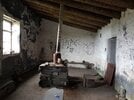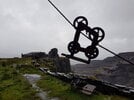Ended up doing a trip up to Dinorwic after visiting some surface features around Blaenau Ffestiniog and suprise suprise I got very wet. I parked on Lon Garret making my way down and back around the top of the large pit.
History:
Dinorwic is a large quarry in Llanberis, North Wales. It was the second largest slate in the world after the nearby Penrhyn quarry.
Quarrying began on a large scale in 1824 after the opening of the Dinorwic railway, a horse drawn tramway, which went to the coast at Port Dinorwic. This railway was very inefficient and was removed by the 1850s after it was replaced by the Padarn railway which was more suited to locomotive haulage. It had an unusual 4ft gauge which allowed it to use wagons which carried two slate wagons side by side.
The quarry itself began life as many different small quarries on various parts of the mountain, many of these areas kept their names throughout their whole workings lives. At its peak in the 19th century the quarry was producing some 100,000 tonnes of slate with a workforce of 3,000. However in the 20th Century slate production became less viable the number of workers reduced to 2,000 in 1930. During the 1960s a combination of factors led to its closure in 1969.
- Large Rockfall in the Garret area
- Poor tipping practices
- Slate no longer being viable
Even some of the largest quarries at the time could no longer survive with Dorothea, Oakeley and Briach Goch closing in 1970.
What they have left behind however is an amazing collection of artefacts and buildings showcasing mans attempt at literally moving mountains.
I begin with a map with the levels marked on the map. The route taken was a circle around the large pit on the centre left starting on the Swallow level. and yes some of the spellings are awful.

A view down the A6 incline, this is now used by Dinorwic power station high voltage cables.

The large pit from Swallow level. The buildings on the right are on Pen garret level.

At the bottom of the pit there is some stairs going down to a lower platform.

Next to this there is an American Ingersoll Rand type 10 compressor.


One of the best features of Dinorwic is the abundance of staircases making getting up between level easy.

We now make our way up to Pen garret level and some buildings that actually still have their roof - A welcome sight in the welsh rain.
Loco shed

A caban

inside


The shitter next door.

Blondin tower with the two winding houses.

Ladder clearly showing the galleries on the opposite of the pit.

Inside the first winding house the wire goes through the roof. Room is full of goat shit lol

Blondin on the wire. There is another on the ground nearby.

The other winding house, here the wire goes out of the building to the bottom right.

Looking towards the blondin. My theory is that one winder was for winding it in and out and the other for up and down.

We now head up a table incline incline to Austrailia level. The anchor for the blondin is located on this level. Note that the drums are visible


Switch Handle

Anchor point

This level contains another compressor building and equipment. I assume the tank is for air as well.



The most famous part of Austrailia level is the saw mill with the remaining lines of rusting saw which will never see a slate again.

This main ran the saws by use of a belts around the wheels. This is the sort of method you would see in the mills from the begining of the industrial revolution.

Top of the ~C5 incline. The bridge has a hole in it so watch your step!

Now up the C6 incline to Egypt level in Post #2
History:
Dinorwic is a large quarry in Llanberis, North Wales. It was the second largest slate in the world after the nearby Penrhyn quarry.
Quarrying began on a large scale in 1824 after the opening of the Dinorwic railway, a horse drawn tramway, which went to the coast at Port Dinorwic. This railway was very inefficient and was removed by the 1850s after it was replaced by the Padarn railway which was more suited to locomotive haulage. It had an unusual 4ft gauge which allowed it to use wagons which carried two slate wagons side by side.
The quarry itself began life as many different small quarries on various parts of the mountain, many of these areas kept their names throughout their whole workings lives. At its peak in the 19th century the quarry was producing some 100,000 tonnes of slate with a workforce of 3,000. However in the 20th Century slate production became less viable the number of workers reduced to 2,000 in 1930. During the 1960s a combination of factors led to its closure in 1969.
- Large Rockfall in the Garret area
- Poor tipping practices
- Slate no longer being viable
Even some of the largest quarries at the time could no longer survive with Dorothea, Oakeley and Briach Goch closing in 1970.
What they have left behind however is an amazing collection of artefacts and buildings showcasing mans attempt at literally moving mountains.
I begin with a map with the levels marked on the map. The route taken was a circle around the large pit on the centre left starting on the Swallow level. and yes some of the spellings are awful.
A view down the A6 incline, this is now used by Dinorwic power station high voltage cables.
The large pit from Swallow level. The buildings on the right are on Pen garret level.
At the bottom of the pit there is some stairs going down to a lower platform.
Next to this there is an American Ingersoll Rand type 10 compressor.
One of the best features of Dinorwic is the abundance of staircases making getting up between level easy.
We now make our way up to Pen garret level and some buildings that actually still have their roof - A welcome sight in the welsh rain.
Loco shed
A caban
inside
The shitter next door.
Blondin tower with the two winding houses.
Ladder clearly showing the galleries on the opposite of the pit.
Inside the first winding house the wire goes through the roof. Room is full of goat shit lol
Blondin on the wire. There is another on the ground nearby.
The other winding house, here the wire goes out of the building to the bottom right.
Looking towards the blondin. My theory is that one winder was for winding it in and out and the other for up and down.
We now head up a table incline incline to Austrailia level. The anchor for the blondin is located on this level. Note that the drums are visible
Switch Handle
Anchor point
This level contains another compressor building and equipment. I assume the tank is for air as well.
The most famous part of Austrailia level is the saw mill with the remaining lines of rusting saw which will never see a slate again.
This main ran the saws by use of a belts around the wheels. This is the sort of method you would see in the mills from the begining of the industrial revolution.
Top of the ~C5 incline. The bridge has a hole in it so watch your step!
Now up the C6 incline to Egypt level in Post #2


